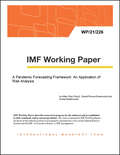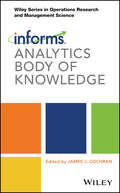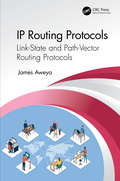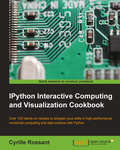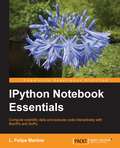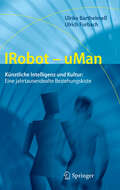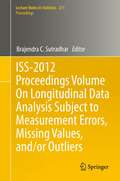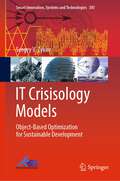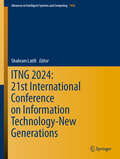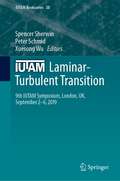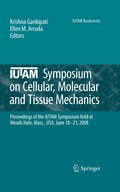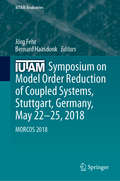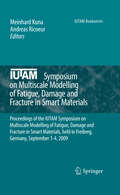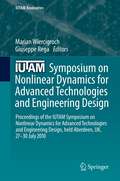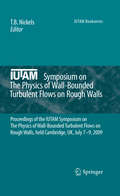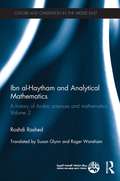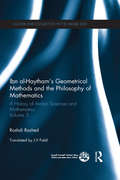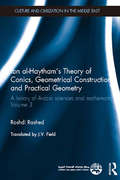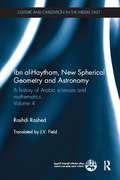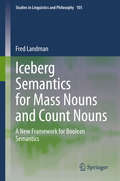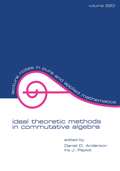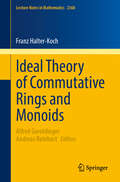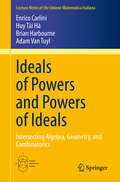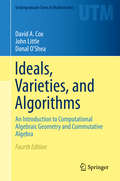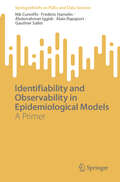- Table View
- List View
IMF: Recent Economic Developments (Imf Working Papers #Imf Staff No. 97/107)
by International Monetary FundA report from the International Monetary Fund.
INFORMS ABOK (Wiley Series in Operations Research and Management Science)
by James J. CochranStandardizes the definition and framework of analytics ABOK stands for Analytics Body of Knowledge. Based on the authors’ definition of analytics—which is “a process by which a team of people helps an organization make better decisions (the objective) through the analysis of data (the activity)”— this book from Institute for Operations Research and the Management Sciences (INFORMS) represents the perspectives of some of the most respected experts on analytics. The INFORMS ABOK documents the core concepts and skills with which an analytics professional should be familiar; establishes a dynamic resource that will be used by practitioners to increase their understanding of analytics; and, presents instructors with a framework for developing academic courses and programs in analytics. The INFORMS ABOK offers in-depth insight from peer-reviewed chapters that provide readers with a better understanding of the dynamic field of analytics. Chapters cover: Introduction to Analytics; Getting Started with Analytics; The Analytics Team; The Data; Solution Methodology; Model Building; Machine Learning; Deployment and Life Cycle Management; and The Blossoming Analytics Talent Pool: An Overview of the Analytics Ecosystem. Across industries and academia, readers with various backgrounds in analytics – from novices who are interested in learning more about the basics of analytics to experienced professionals who want a different perspective on some aspect of analytics – will benefit from reading about and implementing the concepts and methods covered by the INFORMS ABOK.
IP Routing Protocols: Link-State and Path-Vector Routing Protocols
by James AweyaThis book discusses link-state routing protocols (OSPF and IS-IS), and the path-vector routing protocol (BGP). It covers their most identifying characteristics, operations, and the databases they maintain. Material is presented from a practicing engineer’s perspective, linking theory and fundamental concepts to common practices and real-world examples. Every aspect of the book is written to reflect current best practices using real-world examples. The book begins with a detailed description of the OSPF area types and hierarchical routing, and the different types of routers used in an OSPF autonomous system. The author goes on to describe in detail the different OSPF packet types, and inbound and outbound processing of OSPF link-state advertisements (LSAs). Next, the book gives an overview of the main features of IS-IS. The author then discusses the two-level routing hierarchy for controlling the distribution of intra-domain (Level 1) and inter-domain (Level 2) routing information within an IS-IS routing domain. He then describes in detail IS-IS network address formats, IS-IS routing metrics, IS-IS packet types, IS-IS network types and adjacency formation, IS-IS LSDB and synchronization, and IS-IS authentication. The book then reviews the main concepts of path-vector routing protocols, and describes BGP packet types, BGP session states and Finite State Machine, BGP path attributes types, and BGP Autonomous System Numbers (ASNs). Focuses solely on link-state routing protocols (OSPF and IS-IS), and the only path-vector routing protocol in use today (BGP). Reviews the basic concepts underlying the design of IS-IS and provides a detailed description of IS-IS area types and hierarchical routing, and the different types of routers used by IS-IS. Discusses the two-level routing hierarchy for controlling the distribution of intra-domain (Level 1) and inter-domain (Level 2) routing information within an IS-IS routing domain. Describes in detail BGP packet types, BGP session states and Finite State Machine, BGP path attributes types, and BGP ASNs, includes a high-level view of the typical BGP router and its components, and inbound and outbound message processing. James Aweya, PhD, is a chief research scientist at the Etisalat British Telecom Innovation Center (EBTIC), Khalifa University, Abu Dhabi, UAE. He has authored four books including this book and is a senior member of the Institute of Electrical and Electronics Engineers (IEEE).
IPython Interactive Computing and Visualization Cookbook
by Cyrille RossantIntended to anyone interested in numerical computing and data science: students, researchers, teachers, engineers, analysts, hobbyists... Basic knowledge of Python/NumPy is recommended. Some skills in mathematics will help you understand the theory behind the computational methods.
IPython Notebook Essentials
by L. Felipe MartinsIf you are a professional, student, or educator who wants to learn to use IPython Notebook as a tool for technical and scientific computing, visualization, and data analysis, this is the book for you. This book will prove valuable for anyone that needs to do computations in an agile environment.
IRobot - uMan
by Ulrich Furbach Ulrike BarthelmeßWarum werden Roboter oft als bedrohlich empfunden? Können künstliche Systeme Emotionen und Bewusstsein haben? Die Autoren gehen von der These aus, dass die Literatur- und Geistesgeschichte uns helfen kann, aktuelle Entwicklungen der Robotik unvoreingenommen zu betrachten. Denn ob es um mittelalterliche Mythen, androide Roboter der Romantik, die Aufklärung oder die Entwicklung der künstlichen Intelligenz geht, stets stellt sich die Frage nach dem, was der Mensch ist, was sein Bewusstsein ausmacht und was ihn von anderen Wesen unterscheidet.
ISS-2012 Proceedings Volume On Longitudinal Data Analysis Subject to Measurement Errors, Missing Values, and/or Outliers
by Brajendra C. SutradharThis proceedings volume contains nine selected papers that were presented in the International Symposium in Statistics, 2012 held at Memorial University from July 16 to 18. These nine papers cover three different areas for longitudinal data analysis, four dealing with longitudinal data subject to measurement errors, four on incomplete longitudinal data analysis, and the last one for inferences for longitudinal data subject to outliers. Unlike in the independence setup, the inferences in measurement errors, missing values, and/or outlier models, are not adequately discussed in the longitudinal setup. The papers in the present volume provide details on successes and further challenges in these three areas for longitudinal data analysis. This volume is the first outlet with current research in three important areas in the longitudinal setup. The nine papers presented in three parts clearly reveal the similarities and differences in inference techniques used for three different longitudinal setups. Because the research problems considered in this volume are encountered in many real life studies in biomedical, clinical, epidemiology, socioeconomic, econometrics, and engineering fields, the volume should be useful to the researchers including graduate students in these areas.
IT Crisisology Models: Object-Based Optimization for Sustainable Development (Smart Innovation, Systems and Technologies #381)
by Sergey V. ZykovThe book focuses on modeling real-world crisis management in digital product development. This includes models and methods for forecasting, responding, and agile engineering/managing for sustainable product development. This book suggests an approach that contains principles, formal models, and semi-formal practice-oriented methods, patterns and techniques to efficiently manage these crises and provide sustainable development. The book also introduces a set of principles, models, and methods for sustainable management as a blend, the components of which have been carefully selected from a few domains adjacent to digital production such as IT-intensive operation, human resource management, and knowledge engineering, to name a few. The key ingredients of this crisis management framework include smart data modeling, trade-off optimizing, agile product controlling, and knowledge transferring.
ITNG 2024: 21st International Conference on Information Technology-New Generations (Advances in Intelligent Systems and Computing #1456)
by Shahram LatifiThis volume represents the 21st International Conference on Information Technology - New Generations (ITNG), 2024. ITNG is an annual event focusing on state of the art technologies pertaining to digital information and communications. The applications of advanced information technology to such domains as astronomy, biology, education, geosciences, security, and health care are the among topics of relevance to ITNG. Visionary ideas, theoretical and experimental results, as well as prototypes, designs, and tools that help the information readily flow to the user are of special interest. Machine Learning, Robotics, High Performance Computing, and Innovative Methods of Computing are examples of related topics. The conference features keynote speakers, a best student award, poster award, service award, a technical open panel, and workshops/exhibits from industry, government and academia. This publication is unique as it captures modern trends in IT with a balance of theoretical and experimental work. Most other work focus either on theoretical or experimental, but not both. Accordingly, we do not know of any competitive literature.
IUTAM Laminar-Turbulent Transition: 9th IUTAM Symposium, London, UK, September 2–6, 2019 (IUTAM Bookseries #38)
by Peter Schmid Spencer Sherwin Xuesong WuThis volume comprises the carefully revised papers of the 9th IUTAM Symposium on Laminar-Turbulent Transition, held at the Imperial College, London, UK, in September 2019. The papers focus on the leading research in understanding transition to turbulence, which is a challenging topic of fluid mechanics and arises in many modern technologies as well as in nature. The proceedings are of interest for researchers in fluid mechanics and industry who have to handle these types of problems, such as in the aeronautical sector.
IUTAM Symposium on Cellular, Molecular and Tissue Mechanics
by Ellen M. Arruda Krishna GarikipatiThese Proceedings reflect the state of current understanding of the role played by mechanics in biological systems at the molecular, cellular and tissue levels. The invited papers will be notable for the expressed viewpoints of biologists, biophysicists and mechanicians. The topics addressed will range from tissue engineering and tissue mechanics, through cell mechanics, down to the mechanics of biomolecules.
IUTAM Symposium on Model Order Reduction of Coupled Systems, Stuttgart, Germany, May 22–25, 2018: MORCOS 2018 (IUTAM Bookseries #36)
by Jörg Fehr Bernard HaasdonkThis volume contains the proceedings of the IUTAM Symposium on Model Order Reduction of Coupled System, held in Stuttgart, Germany, May 22–25, 2018. For the understanding and development of complex technical systems, such as the human body or mechatronic systems, an integrated, multiphysics and multidisciplinary view is essential. Many problems can be solved within one physical domain. For the simulation and optimization of the combined system, the different domains are connected with each other. Very often, the combination is only possible by using reduced order models such that the large-scale dynamical system is approximated with a system of much smaller dimension where the most dominant features of the large-scale system are retained as much as possible. The field of model order reduction (MOR) is interdisciplinary. Researchers from Engineering, Mathematics and Computer Science identify, explore and compare the potentials, challenges and limitations of recent and new advances.
IUTAM Symposium on Multiscale Modelling of Fatigue, Damage and Fracture in Smart Materials
by Andreas Ricoeur Meinhard KunaToday, multi-functional materials such as piezoelectric/ferroelectric ceramics, magneto-strictive and shape memory alloys are gaining increasing applications as sensors, actuators or smart composite materials systems for emerging high tech areas. The stable performance and reliability of these smart components under complex service loads is of paramount practical importance. However, most multi-functional materials suffer from various mechanical and/or electro-magnetical degra-dation mechanisms as fatigue, damage and fracture. Therefore, this exciting topic has become a challenge to intensive international research, provoking the interdisciplinary approach between solid mechanics, materials science and physics. This book summarizes the outcome of the above mentioned IUTAM-symposium, assembling contributions by leading scientists in this area. Particularly, the following topics have been addressed: (1) Development of computational methods for coupled electromechanical field analysis, especially extended, adaptive and multi-level finite elements. (2) Constitutive modeling of non-linear smart material behavior with coupled electric, magnetic, thermal and mechanical fields, primarily based on micro-mechanical models. (3) Investigations of fracture and fatigue in piezoelectric and ferroelectric ceramics by means of process zone modeling, phase field simulation and configurational mechanics. (4) Reliability and durability of sensors and actuators under in service loading by alternating mechanical, electrical and thermal fields. (5) Experimental methods to measure fracture strength and to investigate fatigue crack growth in ferroelectric materials under electromechanical loading. (6) New ferroelectric materials, compounds and composites with enhanced strain capabilities.
IUTAM Symposium on Nonlinear Dynamics for Advanced Technologies and Engineering Design
by Giuseppe Rega Marian WiercigrochNonlinear dynamics has been enjoying a vast development for nearly four decades resulting in a range of well established theory, with the potential to significantly enhance performance, effectiveness, reliability and safety of physical systems as well as offering novel technologies and designs. By critically appraising the state-of-the-art, it is now time to develop design criteria and technology for new generation products/processes operating on principles of nonlinear interaction and in the nonlinear regime, leading to more effective, sensitive, accurate, and durable methods than what is currently available. This new approach is expected to radically influence the design, control and exploitation paradigms, in a magnitude of contexts. With a strong emphasis on experimentally calibrated and validated models, contributions by top-level international experts will foster future directions for the development of engineering technologies and design using robust nonlinear dynamics modelling and analysis.
IUTAM Symposium on The Physics of Wall-Bounded Turbulent Flows on Rough Walls
by T. B. NickelsThis work describes the state-of-the-art in the understanding of turbulent wall-bounded flows developing on rough surfaces. This symposium brought together the best researchers in the field to discuss the technical issues and develop a consistent approach to the subject - hence it is an up-to-date reference work for research in this area.
Ibn al-Haytham and Analytical Mathematics: A History of Arabic Sciences and Mathematics Volume 2 (Culture and Civilization in the Middle East)
by Roshdi RashedThis volume provides a unique primary source on the history and philosophy of mathematics and the exact sciences in the mediaeval Arab world. The second of five comprehensive volumes, this book offers a detailed exploration of Arabic mathematics in the eleventh century as embodied in the legacy of the celebrated polymath al-Hasan ibn al-Haytham. Extensive analyses and annotations from the eminent scholar, Roshdi Rashed, support a number of key Arabic texts from Ibn al-Haytham’s treatises in infinitesimal mathematics, translated here into English for the first time. Rashed shows how Ibn al-Haytham’s works demonstrate a remarkable mathematical competence in mathematical subjects like the quadrature of the circle and of lunes, the calculation of the volumes of paraboloids, the problem of isoperimetric plane figures and solid figures with equal surface areas, along with the extraction of square and cubic roots. The present text is complemented by the first volume of A History of Arabic Sciences and Mathematics, which focused on founding figures and commentators in the ninth and tenth centuries Archimedean-Apollonian mathematical ‘School of Baghdad’. This constellation of works illustrates the historical and epistemological development of ‘infinitesimal mathematics’ as it became clearly articulated in the oeuvre of Ibn al-Haytham. Contributing to a more informed and balanced understanding of the internal currents of the history of mathematics and the exact sciences in Islam, and of its adaptive interpretation and assimilation in the European context, this fundamental text will appeal to historians of ideas, epistemologists and mathematicians at the most advanced levels of research.
Ibn al-Haytham's Geometrical Methods and the Philosophy of Mathematics: A History of Arabic Sciences and Mathematics Volume 5 (Culture and Civilization in the Middle East)
by Roshdi Rashed and J. V. FieldThis fifth volume of A History of Arabic Sciences and Mathematics is complemented by four preceding volumes which focused on the main chapters of classical mathematics: infinitesimal geometry, theory of conics and its applications, spherical geometry, mathematical astronomy, etc. This book includes seven main works of Ibn al-Haytham (Alhazen) and of two of his predecessors, Thābit ibn Qurra and al-Sijzī: The circle, its transformations and its properties; Analysis and synthesis: the founding of analytical art; A new mathematical discipline: the Knowns; The geometrisation of place; Analysis and synthesis: examples of the geometry of triangles; Axiomatic method and invention: Thābit ibn Qurra; The idea of an Ars Inveniendi: al-Sijzī. Including extensive commentary from one of the world’s foremost authorities on the subject, this fundamental text is essential reading for historians and mathematicians at the most advanced levels of research.
Ibn al-Haytham's Theory of Conics, Geometrical Constructions and Practical Geometry: A History of Arabic Sciences and Mathematics Volume 3 (Culture and Civilization in the Middle East)
by Roshdi RashedTheory of Conics, Geometrical Constructions and Practical Geometry: A History of Arabic Sciences and Mathematics Volume 3, provides a unique primary source on the history and philosophy of mathematics and science from the mediaeval Arab world. The present text is complemented by two preceding volumes of A History of Arabic Sciences and Mathematics, which focused on founding figures and commentators in the ninth and tenth centuries, and the historical and epistemological development of ‘infinitesimal mathematics’ as it became clearly articulated in the oeuvre of Ibn al-Haytham. This volume examines the increasing tendency, after the ninth century, to explain mathematical problems inherited from Greek times using the theory of conics. Roshdi Rashed argues that Ibn al-Haytham completes the transformation of this ‘area of activity,’ into a part of geometry concerned with geometrical constructions, dealing not only with the metrical properties of conic sections but with ways of drawing them and properties of their position and shape. Including extensive commentary from one of world’s foremost authorities on the subject, this book contributes a more informed and balanced understanding of the internal currents of the history of mathematics and the exact sciences in Islam, and of its adaptive interpretation and assimilation in the European context. This fundamental text will appeal to historians of ideas, epistemologists and mathematicians at the most advanced levels of research.
Ibn al-Haytham, New Astronomy and Spherical Geometry: A History of Arabic Sciences and Mathematics Volume 4 (Culture and Civilization in the Middle East)
by Roshdi RashedThis volume provides a unique primary source on the history and philosophy of mathematics and science from the mediaeval Arab world. The fourth volume of A History of Arabic Sciences and Mathematics is complemented by three preceding volumes which focused on infinitesimal determinations and other chapters of classical mathematics. This book includes five main works of the polymath Ibn al-Haytham (Alhazen) on astronomy, spherical geometry and trigonometry, plane trigonometry and studies of astronomical instruments on hour lines, horizontal sundials and compasses for great circles. In particular, volume four examines: the increasing tendency to mathematize the inherited astronomy from Greek sources, namely Ptolemy's Almagest; the development of celestial kinematics; new research in spherical geometry and trigonometry required by the new kinematical theory; the study on astronomical instruments and its impact on mathematical research. These new historical materials and their mathematical and historical commentaries contribute to rewriting the history of mathematical astronomy and mathematics from the 11th century on. Including extensive commentary from one of the world’s foremost authorities on the subject, this fundamental text is essential reading for historians and mathematicians at the most advanced levels of research.
Iceberg Semantics for Mass Nouns and Count Nouns: A New Framework for Boolean Semantics (Studies in Linguistics and Philosophy #105)
by Fred LandmanIceberg semantics is a new framework of Boolean semantics for mass nouns and count nouns in which the interpretation of a noun phrase rises up from a generating base and floats with its base on its Boolean part set, like an iceberg. The framework is shown to preserve the attractive features of classical Boolean semantics for count nouns; the book argues that Iceberg semantics forms a much better framework for studying mass nouns than the classical theory does. Iceberg semantics uses its notion of base to develop a semantic theory of the differences between mass nouns and count nouns and between different types of mass nouns, in particular between prototypical mass nouns (here called mess mass nouns) like water and mud versus object mass nouns (here called neat mass nouns) like poultry and pottery. The book shows in detail how and why neat mass nouns pattern semantically both with mess mass nouns and with count nouns. Iceberg semantics is a compositional theory and in Iceberg semantics the semantic distinctions defined apply to noun phrases of any complexity. The book studies in depth the semantics of classifier noun phrases (like three glasses of wine) and measure noun phrases (like three liters of wine). The classical wisdom is that classifier interpretations are count. Recent literature has argued compellingly that measure interpretations are mass. The book shows that both connections follow from the basic architecture of Iceberg semantics.Audience: Scholars and students in linguistics - in particular semantics, pragmatics, computational linguistics and syntax – and neighbouring disciplines like logic, philosophy of language, and cognitive science.
Ideal Theoretic Methods in Commutative Algebra (Lecture Notes in Pure and Applied Mathematics)
by Daniel D. Anderson Ira J. PapickIncludes current work of 38 renowned contributors that details the diversity of thought in the fields of commutative algebra and multiplicative ideal theory. Summarizes recent findings on classes of going-down domains and the going-down property, emphasizing new characterizations and applications, as well as generalizations for commutative rings wi
Ideal Theory of Commutative Rings and Monoids (Lecture Notes in Mathematics #2368)
by Franz Halter-KochThis book offers a concise treatment of multiplicative ideal theory in the language of multiplicative monoids. It presents a systematic development of the theory of weak ideal systems and weak module systems on arbitrary commutative monoids. Examples of monoids that are investigated include, but are not limited to, Mori monoids, Laskerian monoids, Prüfer monoids and Krull monoids. An in-depth study of various constructions from ring theory is also provided, with an emphasis on polynomial rings, Kronecker function rings and Nagata rings. The target audience is graduate students and researchers in ring and semigroup theory.
Ideals of Powers and Powers of Ideals: Intersecting Algebra, Geometry, and Combinatorics (Lecture Notes of the Unione Matematica Italiana #27)
by Adam Van Tuyl Enrico Carlini Huy Tài Hà Brian HarbourneThis book discusses regular powers and symbolic powers of ideals from three perspectives– algebra, combinatorics and geometry – and examines the interactions between them. It invites readers to explore the evolution of the set of associated primes of higher and higher powers of an ideal and explains the evolution of ideals associated with combinatorial objects like graphs or hypergraphs in terms of the original combinatorial objects. It also addresses similar questions concerning our understanding of the Castelnuovo-Mumford regularity of powers of combinatorially defined ideals in terms of the associated combinatorial data. From a more geometric point of view, the book considers how the relations between symbolic and regular powers can be interpreted in geometrical terms. Other topics covered include aspects of Waring type problems, symbolic powers of an ideal and their invariants (e.g., the Waldschmidt constant, the resurgence), and the persistence of associated primes.
Ideals, Varieties, and Algorithms: An Introduction to Computational Algebraic Geometry and Commutative Algebra (Undergraduate Texts in Mathematics)
by John Little David A. Cox Donal O'SheaThis text covers topics in algebraic geometry and commutative algebra with a strong perspective toward practical and computational aspects. The first four chapters form the core of the book. A comprehensive chart in the Preface illustrates a variety of ways to proceed with the material once these chapters are covered. In addition to the fundamentals of algebraic geometry--the elimination theorem, the extension theorem, the closure theorem and the Nullstellensatz--this new edition incorporates several substantial changes, all of which are listed in the Preface. The largest revision incorporates a new Chapter (ten), which presents some of the essentials of progress made over the last decades in computing Gröbner bases. The book also includes current computer algebra material in Appendix C and updated independent projects (Appendix D). The book may serve as a first or second course in undergraduate abstract algebra and with some supplementation perhaps, for beginning graduate level courses in algebraic geometry or computational algebra. Prerequisites for the reader include linear algebra and a proof-oriented course. It is assumed that the reader has access to a computer algebra system. Appendix C describes features of Maple(tm), Mathematica® and Sage, as well as other systems that are most relevant to the text. Pseudocode is used in the text; Appendix B carefully describes the pseudocode used. From the reviews of previous editions: ". . . The book gives an introduction to Buchberger's algorithm with applications to syzygies, Hilbert polynomials, primary decompositions. There is an introduction to classical algebraic geometry with applications to the ideal membership problem, solving polynomial equations and elimination theory. . . . The book is well-written. . . . The reviewer is sure that it will be an excellent guide to introduce further undergraduates in the algorithmic aspect of commutative algebra and algebraic geometry. " --Peter Schenzel, zbMATH, 2007 "I consider the book to be wonderful. . . . The exposition is very clear, there are many helpful pictures and there are a great many instructive exercises, some quite challenging . . . offers the heart and soul of modern commutative and algebraic geometry. " --The American Mathematical Monthly
Identifiability and Observability in Epidemiological Models: A Primer (SpringerBriefs on PDEs and Data Science)
by Alain Rapaport Nik Cunniffe Frédéric Hamelin Abderrahman Iggidr Gauthier SalletThis book introduces the concepts of identifiability and observability in mathematical epidemiology, as well as those of observers’ constructions. It first exposes and illustrates on several examples the mathematical definitions and properties of observability and identifiability. A chapter is dedicated to the well-known Kermack McKendrick model, for which the complete analysis of identifiability and observability is not available in the literature. Then, several techniques of observer constructions, in view of online estimation of state and parameters, are presented and deployed on several models. New developments relevant for applications in epidemiology are also given. Finally, practical considerations are discussed with data and numerical simulations related to models previously analysed in the book. The book will be appealing to epidemiological modellers and mathematicians working on models in epidemiology.This book contributes to Sustainable Development Goal 3 (SDG3): Good Health and Well Being.
